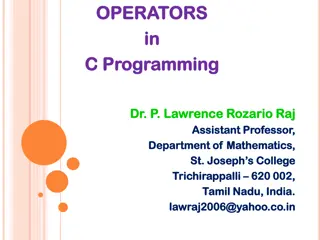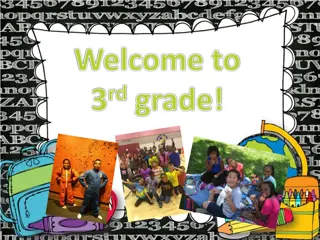Exploring Multiplication and Division Strategies for 3rd Grade Math
Delve into the world of multiplication and division for 3rd graders with a focus on understanding equal groups, arrays, repeated addition, and more. Explore strategies, solve word problems, and enhance fluency with factors up to 10. Practice skip counting by 2s, 5s, and 10s in a fun classroom activity.
Download Presentation

Please find below an Image/Link to download the presentation.
The content on the website is provided AS IS for your information and personal use only. It may not be sold, licensed, or shared on other websites without obtaining consent from the author. Download presentation by click this link. If you encounter any issues during the download, it is possible that the publisher has removed the file from their server.
E N D
Presentation Transcript
Math Routines Cluster 4: Making Sense of Multiplication and Division Created by 3rdGrade Tools For Teachers Pilot Teachers in Kannapolis City Schools and Richmond County Schools
Standards NC.3.OA.1 NC.3.OA.2 NC.3.OA.3 NC.3.OA.6 For products of whole numbers with two factors up to and including 10: Interpret the factors as representing the number of equal groups and the number of objects in each group. Illustrate and explain strategies including arrays, repeated addition, decomposing a factor, and applying the commutative and associative properties. For whole-number quotients of whole numbers with a one-digit divisor and a one- digit quotient: Interpret the divisor and quotient in a division equation as representing the number of equal groups and the number of objects in each group. Illustrate and explain strategies including arrays, repeated addition or subtraction, and decomposing a factor. Represent, interpret, and solve one-step problems involving multiplication and division. Solve multiplication word problems with factors up to and including 10. Represent the problem using arrays, pictures, and/or equations with a symbol for the unknown number to represent the problem. Solve division word problems with a divisor and quotient up to and including 10. Represent the problem using arrays, pictures, repeated subtraction and/or equations with a symbol for the unknown number to represent the problem. Solve an unknown-factor problem, by using division strategies and/or changing it to a multiplication problem.
Standards NC.3.OA.7 NC.3.OA.8 NC.3.OA.9 NC.3.NBT.3 Demonstrate fluency with multiplication and division with factors, quotients, and divisors up to and including 10: Know from memory all products with factors up to and including 10. Illustrate and explain using the relationship between multiplication and division. Determine the unknown whole number in a multiplication or division equation relating three whole numbers. Solve two-step word problems using addition, subtraction, and multiplication, representing problems using equations with a symbol for the unknown number. Interpret patterns of multiplication on a hundreds board and/or multiplication table. Use concrete and pictorial models, based on place value and the properties of operations, to find the product of a one-digit whole number by a multiple of 10 in the range 10-90.
Count Around the Room Starting with one classmate, skip count by tens. Make sure to pay attention and count in your head as each person says their number. I will record the numbers on the board.
Count Around the Room Starting with one classmate, skip count by fives. Make sure to pay attention and count in your head as each person says their number. I will record the numbers on the board.
Count Around the Room Starting with one classmate, skip count by twos. Make sure to pay attention and count in your head as each person says their number. I will record the numbers on the board.
Would You Rather... .have 6 bags of 4 cookies each? or have 5 bags of 5 cookies each? Support Your Answer
Would You Rather... ...have 4 bags of 5 lollipops each? or have 8 bags of 2 lollipops each ? Support Your Answer
Would You Rather... ...earn $7 a day for 3 days? or earn $3 a day for 7 days? Support Your Answer
Would You Rather... ...work 5 days for 7 hours each day? or 7 days for 5 hours each day? Support Your Answer
Would You Rather... ...share 24 cookies evenly with 4 friends or share 24 cookies evenly with 6 friends? Support Your Answer
Would You Rather... ...split $30 evenly with 3 friends? or split $40 evenly with 5 friends? Support Your Answer
Guess My Rule 21, 24, 27, 30, 33...
Guess My Rule 12, 16, 20, 24, 28...
Guess My Rule 3, 6, 12, 24, 48...
Target Number: Find as many representations as you can using a multiplication or division strategy. 10
Target Number: Find as many representations as you can using a multiplication or division strategy. 36
Target Number: Find as many representations as you can using a multiplication or division strategy. 21
Target Number: Find as many representations as you can using a multiplication or division strategy. 16
Sparkle: Skip count by 5 s to 50.
Sparkle: Skip count by 4 s to 40.
Sparkle: Skip count by 20 s to 200.
Talk a Mile a Minute: Multiply
Talk a Mile a Minute: Divide
Broken Calculator: 5 X 3
Broken Calculator: 6 X 7
Broken Calculator: 4 X 10
Broken Calculator: 72 8
Numberless Word Problem: Set 1 There were some beavers chewing trees to cut them down. Each beaver cut down the same number of trees.
Numberless Word Problem: Set 1 There were 3 beavers chewing trees to cut them down. Each beaver cut down the same number of trees.
Numberless Word Problem: Set 1 There were 3 beavers chewing trees to cut them down. Each beaver cut down 5 trees.
Numberless Word Problem: Set 1 There were 3 beavers chewing trees to cut them down. Each beaver cut down 5 trees. How many total trees did they cut down?
Numberless Word Problem: Set 2 Heather has some stickers she is going to put into some treat bags for her birthday party. She puts the same number of stickers in each bag.
Numberless Word Problem: Set 2 Heather has some stickers she is going to put into 4 treat bags for her birthday party. She puts the same number of stickers in each bag.
Numberless Word Problem: Set 2 Heather has 12 stickers she is going to put into 4 treat bags for her birthday party. She puts the same number of stickers in each bag.
Numberless Word Problem: Set 2 Heather has 12 stickers she is going to put into 4 treat bags for her birthday party. She puts the same number of stickers in each bag. How many stickers does she put in each bag?
Numberless Word Problem: Set 3 The florist has some roses. She is going to use some of the roses in each bouquet she makes.
Numberless Word Problem: Set 3 The florist has 24 roses. She is going to use some of the roses in each bouquet she makes.
Numberless Word Problem: Set 3 The florist has 24 roses. She is going to use 6 of the roses in each bouquet she makes.
Numberless Word Problem: Set 3 The florist has 24 roses. She is going to use 6 of the roses in each bouquet she makes. How many bouquets can she make using all of the roses?
Numberless Word Problem: Additional Examples A farmer bought some cows. If you know how much he paid and how many cows he bought, how can you find the price of one cow?
Numberless Word Problem: Additional Examples Some horses and chickens are in a barn; the total number of heads and wings equals the number of feet. How many horses and how many chickens are there?
Numberless Word Problem: Additional Examples If I know the number of rows of trees in a square orchard and the total number of trees, how can I find the number in each row?























